How To Make Piak Poon – Tapioca Pudding With Coconut Milk
Piak Poon is a luscious Southeast Asian dessert featuring tapioca pearls simmered in coconut milk until creamy and translucent. You’ll find this comforting treat at celebrations throughout Thailand, Malaysia, and Indonesia, where it’s often infused with pandan leaves or palm sugar. When making it at home, gently cook your tapioca pearls before adding coconut milk and stirring in a figure-eight motion. This centuries-old recipe connects generations through its perfect balance of tropical flavors and comforting texture.
Key Takeaways
- Piak Poon is a Southeast Asian tapioca pudding variation made with coconut milk and often flavored with pandan leaves.
- The dessert features small tapioca pearls cooked until translucent, then combined with rich coconut milk and sweeteners.
- This traditional pudding combines Portuguese-introduced tapioca with local ingredients, creating a culturally significant dessert across Thailand, Malaysia, and Indonesia.
- Cooking techniques include gentle simmering, figure-eight stirring motions, and gradual incorporation of coconut milk for ideal texture.
- Customization options include adding palm sugar, tropical fruits, or spices while maintaining its creamy, comforting essence.
History
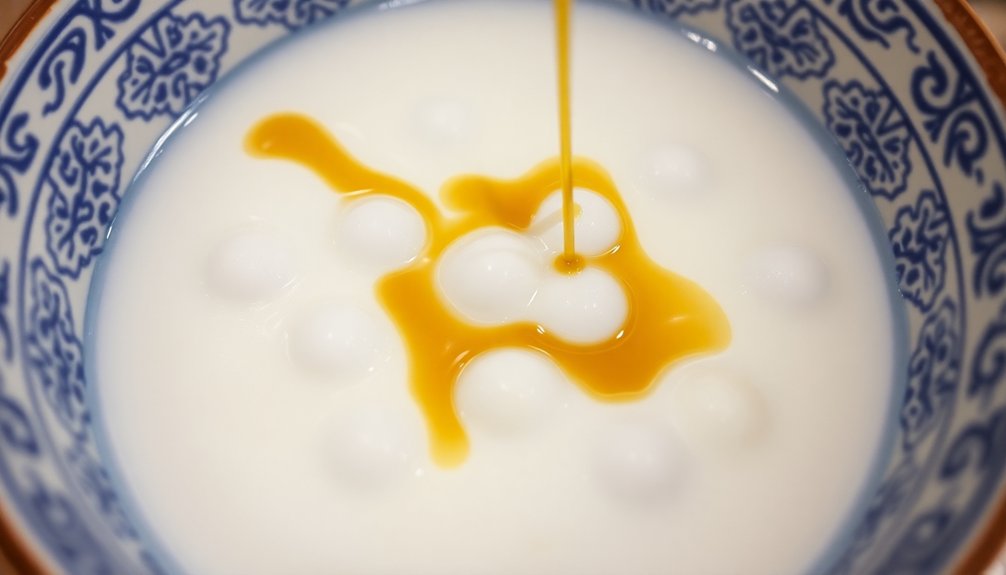
Although the origins of tapioca pudding stretch back centuries, its marriage with coconut milk represents a fascinating cultural fusion. You’ll find this delightful combination most prominently in Southeast Asian cuisines, where tapioca pearls have been a dietary staple since Portuguese traders introduced cassava from South America in the 16th century.
The cultural significance of this humble dessert can’t be overstated in countries like Thailand, Malaysia, and Indonesia, where it often appears at celebrations and family gatherings.
You’ll discover regional variations that reflect local tastes and available ingredients – some recipes incorporate pandan leaves for color and aroma, while others feature palm sugar or tropical fruits.
What began as simple sustenance evolved into a beloved comfort food that crosses socioeconomic boundaries, connecting generations through shared culinary traditions.
Recipe
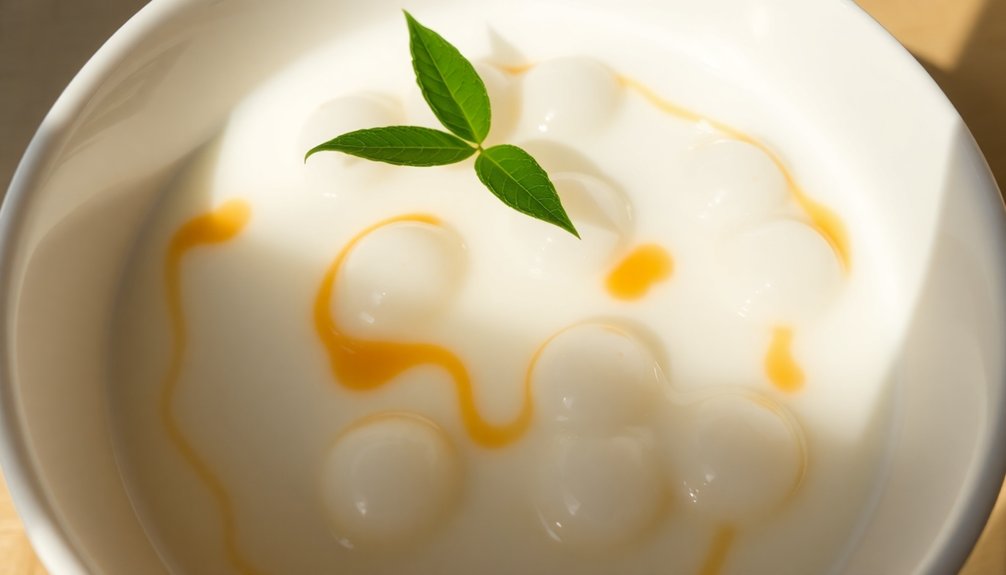
Ingredients
- 1/2 cup small tapioca pearls
- 2 cups water (for soaking)
- 1 can (14 oz) coconut milk
- 1/2 cup sugar
- 1/4 teaspoon salt
- 2 eggs, beaten
- 1 teaspoon vanilla extract
- Toasted coconut flakes (optional, for garnish)
Instructions
- Soak tapioca pearls in water for 30 minutes, then drain.
- In a medium saucepan, combine coconut milk, drained tapioca pearls, sugar, and salt.
- Bring the mixture to a simmer over medium heat, stirring constantly.
- Reduce heat to low and cook for 15-20 minutes until tapioca pearls become translucent.
- In a small bowl, whisk the beaten eggs.
- Temper the eggs by gradually adding 1/2 cup of the hot tapioca mixture while whisking continuously.
- Pour the egg mixture back into the saucepan and cook for another 2-3 minutes, stirring constantly.
- Remove from heat and stir in vanilla extract.
- Transfer to serving dishes and let cool at room temperature.
- Refrigerate for at least 2 hours before serving.
- Garnish with toasted coconut flakes if desired.
Cooking Steps
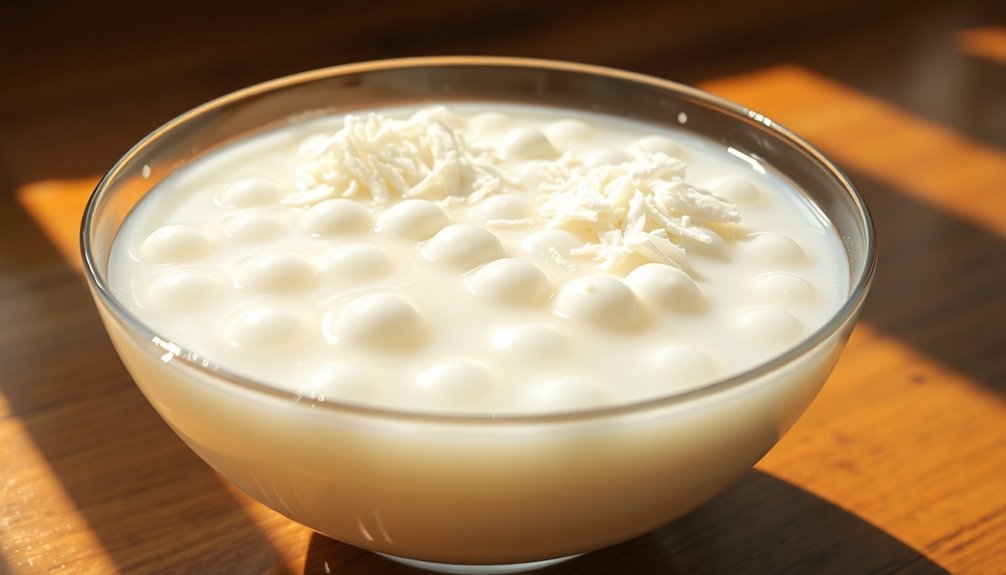
To create perfect tapioca pudding with coconut milk, you’ll need to follow several critical steps with care and attention.
Start by thoroughly rinsing your tapioca pearls before gently cooking them until they become translucent.
Then introduce your flavoring ingredients while slowly incorporating the rich coconut milk.
Once fully combined, you’ll want to let your pudding cool completely before serving, allowing the flavors to harmonize and the texture to set properly.
Step 1. Rinse Tapioca Pearls Thoroughly
Washing your tapioca pearls thoroughly before cooking is an essential step that shouldn’t be skipped. Proper rinsing removes excess starch and prevents your pudding from becoming too gummy or cloudy.
One of the key tapioca benefits is its versatility, but without proper preparation, you’ll miss out on the ideal texture.
Follow these rinsing techniques for maximum results:
- Place your tapioca pearls in a fine-mesh strainer
- Run cold water over them, gently stirring with your fingers
- Continue rinsing until the water runs clear, usually 2-3 minutes
- Drain completely before adding to your cooking liquid
You’ll notice the difference in your final pudding’s clarity and consistency. Clean pearls create that signature bouncy texture that makes Piak Poon so delightful.
step 2. Gently Cook Tapioca Pearls
After thorough rinsing, your tapioca pearls are ready for the cooking process, which demands a gentle touch for perfect results.
Place them in a pot with 4 cups of water and bring to a gentle simmer over medium heat. Avoid boiling vigorously, as this can break the pearls or create an uneven texture.
Stir occasionally to prevent sticking, and cook for about 15-18 minutes until the pearls become translucent with just a tiny white center. You’ll notice they’ll float to the surface as they cook.
The perfect texture happens when they’re tender but still slightly chewy—similar to al dente pasta. Once cooked, drain them immediately and rinse under cool water to stop the cooking process, preparing them for the coconut milk mixture.
Step 3. Add Flavoring Ingredients
With your tapioca pearls perfectly cooked, it’s time to infuse your pudding with the rich, aromatic flavors that make this dessert truly memorable.
These flavorful enhancements transform simple tapioca into a luxurious treat that captivates your senses.
- Pour in coconut milk, stirring gently to maintain the integrity of the pearls while creating a silky base.
- Add your sweetener of choice—palm sugar offers authentic flavor, though honey or maple syrup make excellent ingredient substitutions.
- Incorporate a touch of salt to amplify the sweetness and balance the overall flavor profile.
- Finish with vanilla extract or pandan essence, whichever aromatic note complements your preference.
For dietary restrictions, consider adjusting your ingredient substitutions accordingly—almond milk works well for those avoiding coconut, while stevia can replace traditional sweeteners for a lower-calorie option.
Step 4. Add Coconut Milk Slowly
The proper addition of coconut milk represents one of the most essential steps in creating luxurious tapioca pudding. After your tapioca pearls have reached transparency, reduce the heat to low before introducing the coconut milk.
Pour the coconut milk in gradually, about a quarter cup at a time, while continuously stirring. This methodical approach prevents curdling and guarantees a silky coconut consistency throughout.
The milk temperature should be room temperature—never cold from the refrigerator—as cold liquid can cause the pudding to seize and become lumpy.
As you incorporate the coconut milk, you’ll notice the mixture becoming creamier. Don’t rush this process; allowing each addition to fully integrate creates the signature velvety texture that makes authentic Piak Poon so irresistible.
Your patience here will be rewarded with perfectly balanced flavors.
Step 5. Let Cool Before Serving
Cooling your tapioca pudding properly represents an essential final step that many home cooks unfortunately rush.
The serving temperature directly impacts the pudding’s texture, flavor profile, and overall enjoyment. After removing your pot from heat, you’ll want to follow these cooling guidelines to achieve that perfect texture contrast between the chewy tapioca pearls and smooth coconut base:
- Allow the pudding to cool at room temperature for 15-20 minutes, stirring occasionally to prevent a skin from forming.
- Transfer to individual serving dishes while still slightly warm.
- Cover with plastic wrap touching the surface to prevent condensation.
- Refrigerate for at least 2 hours before serving for the best texture contrast between the firm pearls and creamy pudding.
Cooking Tips
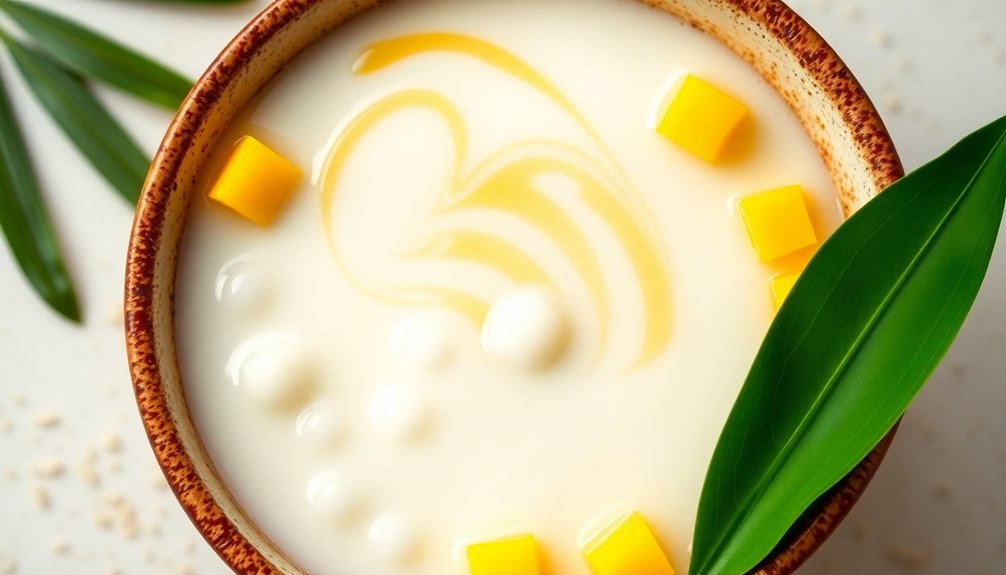
When making tapioca pudding with coconut milk, achieving the perfect consistency depends largely on your stirring technique. Use a wooden spoon and stir constantly in a figure-eight motion to prevent the mixture from sticking to the bottom of your pot.
Don’t rush the cooking process—allow the tapioca pearls to become translucent and soft, which typically takes 15-20 minutes over medium-low heat.
For ingredient substitutions, you can replace regular sugar with palm sugar for a more authentic flavor profile. If coconut milk is too rich for your taste, try using a mixture of coconut milk and light coconut milk. You’ll still get that tropical essence without overwhelming creaminess.
For a vegan version, skip the egg and add a tablespoon of cornstarch mixed with cold water to help thicken your pudding.
Final Thoughts
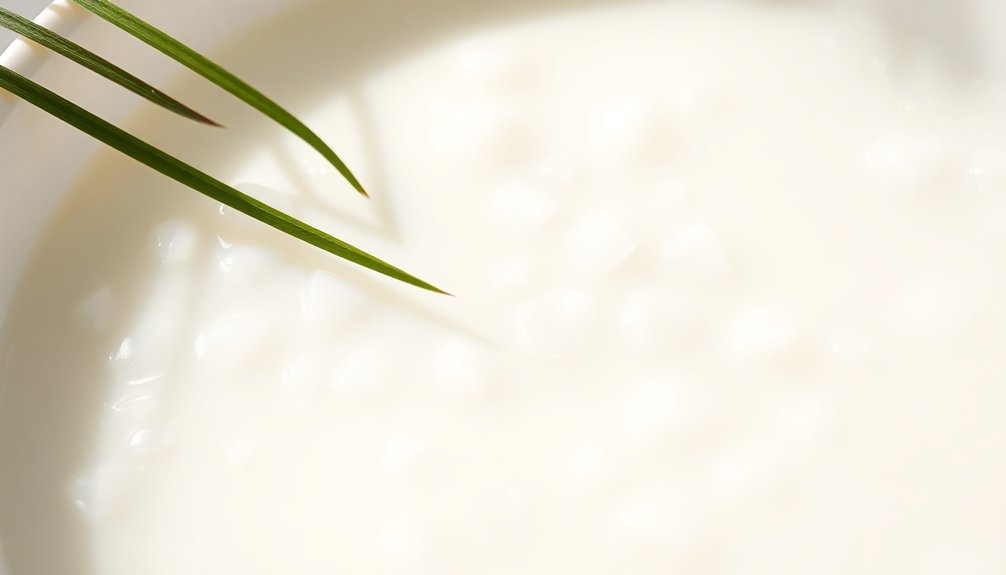
After mastering the art of tapioca pudding with coconut milk, you’ll find yourself returning to this recipe whenever comfort and elegance are needed in equal measure.
The creamy texture and tropical essence make it a perfect pairing for both casual family dinners and sophisticated gatherings.
When savoring flavors of this classic dessert, remember these key points:
- Let the pudding cool completely before refrigerating for the best texture development.
- Store leftover pudding in an airtight container for up to three days.
- Experiment with seasonal fruits to create unique flavor combinations.
- Trust your instincts when adjusting sweetness—coconut milk varieties differ in natural sugar content.
This versatile dessert bridges cultural traditions while offering endless possibilities for personalization.
Frequently Asked Questions
How Long Can Piak Poon Be Stored in the Refrigerator?
Imagine finding yesterday’s dessert still fresh! You’ll enjoy a 3-5 day shelf life when you store it properly. For best refrigeration tips, keep it covered in an airtight container to maintain its creamy texture.
Is Piak Poon Suitable for People With Gluten Intolerance?
Yes, you’re in luck! Tapioca pudding is naturally gluten-free, offering benefits for those with celiac disease or gluten intolerance. When considering dietary considerations, always check additional ingredients for potential cross-contamination.
Can I Substitute Tapioca Pearls With Another Ingredient?
Wondering what to use instead? You can substitute tapioca pearls with chia seeds, sago pearls, or rice for alternative ingredients that maintain pudding variations while preserving the creamy texture you’re seeking.
What Are Traditional Serving Occasions for Piak Poon?
You’ll typically enjoy this dessert during festive celebrations like Lunar New Year or Songkran. It’s also a beloved staple at family gatherings, where its creamy sweetness brings everyone together after meals.
How Does Piak Poon Compare to Western Tapioca Pudding?
Picture a silky dance of textures on your tongue. You’ll notice Western tapioca’s milder dairy base versus piak poon’s rich coconut milk, creating distinct flavor profiles and a smoother, more tropical texture difference.
